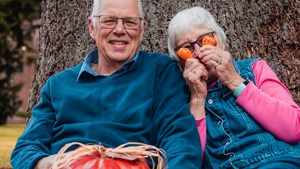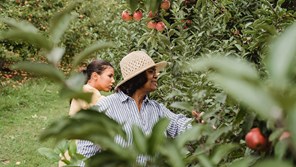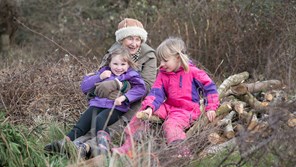The best things to do in autumn for all generations
5 minute read

The days may be getting shorter but that doesn’t mean you have to batten down the hatches just yet. Autumn brings a change of weather, but also a host of activities for people of all ages.
In this article we take a look at some of the top activities that you can do at this time of year, and which hold appeal for older people, adults and children alike. Whether you’re going on a family adventure or a local or community outing, read on for our top autumnal activities.

Age Co Insurance
We offer products and services to help the over 50s get more out of later life and give our profits to the charity Age UK.
Foraging
After a long summer, hedgerows across the UK have had plenty of time and sunlight to deliver an autumn bounty. According to the Woodland Trust, the conditions in 2025 have been right for a ‘mast’ year, with acorns, berries and conkers in abundance.
It’s a great time for foraging, especially with the extensive information available to guide you on the internet.
“We are the first generation of foragers to have access to a whole wealth of knowledge at our fingertips,” says Lucy Buckle, known as the Nottingham Forager.
She emphasises that it’s vital to make sure you know exactly what you’re picking before eating it. “The most important piece of advice I can give anyone is ‘don't munch on a hunch.’ Until you are 100% sure of what you are picking, it’s not worth the risk of consuming.”
Buckle recommends looking to the bounty of fruits on offer in autumn. “Hawthorn, rosehips and sloes are all easy to identify and plentiful around most of the UK,” she says. “You will also find lots of apples and the occasional pear tree among those hedgerows, too.”
She suggests starting slowly. “It’s tempting to want to identify and pick everything you see when you first start. I would always recommend beginning with one or two wild foods and building your knowledge up.”
Some of the best foraging finds could be right in your neighbourhood. “You would be amazed at what I find at small local parks, open spaces and quiet wild corners,” she says. “You don’t need to walk for hours to forage, you just need to pay attention.”
At the same time, you’ll want to ensure you’re staying safe. The Food Standards Agency advises against collecting any plant or fruit that looks damaged (is bruised or mouldy) or could have been grown in contaminated soil. It’s also a good idea to avoid plants that are low to the ground and might have been contaminated by animals.

Legally you are allowed to forage on public land as long as it is not an SSSI (Site of Special Scientific Interest) and you’re foraging for personal use, rather than commercial gain. If you want to forage on private land, you’ll need the landowner’s permission first. You’ll also need permission before digging up any plants, as some plants must not be uprooted.
Read the Food Standards Agency’s guidance on safe foraging.
Jam-making
What to do with the fruits of your foraging? Make jam, of course! You’ll need fresh fruit, sugar and perhaps a few other simple ingredients such as lemon juice or pectin to help the jam set. You’ll also need a large pan, wooden spoon and a ladle, and clean jars with lids. Children can help with simple steps such as washing fruit, stirring the mixture or decorating the labels. Create small batches in an afternoon or spend a whole day experimenting with different flavours. Check out the BBC Food website for some fab recipes.

Over 50s Home Insurance
Age Co helps you protect the things you love. We’re 100% owned by Age UK and our profits go back to the charity.
Pumpkin carving
Pumpkin carving is the ultimate autumn activity, bringing out everyone’s creative side. For extra inspiration, look up the jaw-dropping work of world-famous carvers such as Ray Villafane or Jon Neill, whose sculpted pumpkins often go viral on social media. Use special pumpkin carving tools rather than sharp kitchen knives and let younger children help with scooping and drawing instead of cutting. Many UK farms host pumpkin picking and carving events, which means you can leave the mess there. They may even offer you some hearty soup!
Bird spotting
“The beauty of birdwatching is that you don’t need any equipment to do it,” says Mey Duek from the RSPB. “Of course, you can use binoculars if you want more detail and to see the birds close-up but all you really need is a comfy spot, some patience and a keen eye. Don’t just look upwards – many common species can be spotted in bushes or hedges, or foraging on the ground for food.
“Why not turn it into a game?” Duek adds. “Encourage the family to keep a tally of the different species they can see or close your eyes and see how many different bird calls you can hear. There are lots of apps, websites or CDs out there to learn about different bird calls.” You’ll likely be stationary for prolonged periods so make sure you bring warm clothes.

Campfire storytelling
Why not build a safe bonfire or gather around a sheltered firepit for storytelling? Use dry wood, keep water nearby and ensure you stick to the safety rules with children, such as keeping a good distance, tying back long hair and never leaving a fire unattended. Share some family memories or spooky stories or why not take turns in reciting poems or performing songs?
Rambling
Stretch your legs and discover the UK’s scenic beauty on a family walk. If you don’t know where to start, you can search for routes near you on the Ramblers Association website. From Cornwall to the Highlands, there are plenty of great picks for cross-generational adventures and golden leaves.
Your phone’s mapping tools and more specialised apps such as the Ordnance Survey app can help with navigation. But always carry a paper map (and ideally a compass) to ensure you have a fallback option if your phone loses data signal or runs out of battery.
Make sure someone outside your group knows where you are and how long you plan to be out. Ensure you have appropriate clothing and footwear for the conditions, take plenty of snacks and water and, where possible, ensure your walk is circular to make it easier to get back to base.
Playing conkers
Autumn’s classic conker fight means searching for the shiniest, hardest conker and threading it on to a strong string. Some people swear by soaking and baking conkers for extra toughness. Let each person pit their best conker against others in family-wide (or even neighbourhood) battles.
Who knows – if you get really good, next autumn you could be taking part in the World Conker Championships. Held in Northamptonshire every October, this year it’s celebrating its 60th anniversary.

Sign up to the Age Co Newsletter
Each month, our email newsletter delivers inspiring stories, practical guides to later life, plus the latest news about Age Co and the charitable work we support.
